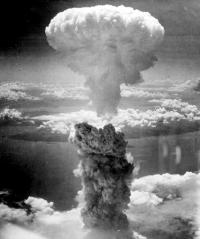Megadeath: the end is nigh
Published in 20th-century / Contemporary History, General, Issue 1(Jan/Feb 2013), News, Volume 21
The atomic bombing of Nagasaki on 9 August 1945 as photographed from one of the B-29 Superfortresses used in the attack. Irish minister to Washington Robert Brennan reported to Dublin on the attack on Hiroshima three days earlier: ‘The centre of the city for three miles was flattened out and nothing was left but a sea of cinders and ashes.’
DIFP VIII covers the immediate post-war years, a period ignored by many historians of Irish foreign policy. The volume explores a vital question facing Iveagh House: after ‘the Emergency’, where next for Ireland in the uncertain world of the early Cold War?
Global destruction was a strong theme in immediate post-war Irish diplomatic traffic. Unlike Dr Strangelove, Irish diplomats could not ‘stop worrying and learn to love the bomb’. After talking to an American military source, Irish minister to Washington Robert Brennan reported to Dublin on the attack on Hiroshima and the destructive capacity of atomic weapons: ‘The centre of the city for three miles was flattened out and nothing was left but a sea of cinders and ashes’.
There was no doubt that atomic weapons would spread worldwide. High commissioner in London John Dulanty learned from his contacts in Whitehall that a Soviet atomic bomb would exist by 1946 (it would take until 1949). Edward Phelan, the Irish head of the International Labour Office, considered that in a Third World War
‘Not only civilisation, but the planet itself might be destroyed. The discovery of the principle of the atomic bomb will, no doubt, be carried further, till the “chain reaction” which produces the continuous fission of atoms can be produced at will in other than those rare elements which have so far been used.’
Minister to Switzerland Frank Cremins began to explore concepts that later became the basis of Cold War nuclear politics:
‘. . . the destructive power of the atomic bomb is so appalling that it would be suicide for any State now to risk aggression unless it was well provided with this means of attack. Even then, mutual destruction might result.’
Other concepts in Cremins’s 1945 reports make familiar reading in the 21st century:
‘. . . the question of a surprise attack by some State or other cannot be left out of account . . . It will be a question of early surprise for the destruction of vital centres . . . and of whether the other State or States will await the surprise.’
Brennan reported that American military opinion voiced ‘regret that the defeat of Germany was so thorough on the grounds that there is now no barrier to Russian expansion’. He added that President Roosevelt ‘realised too late that it would be a disaster to bring about a situation which would leave Russia master of the field and that it was this realization which killed him’. Russia was certainly the global threat, but did Moscow want another world war?
By July 1946 Brennan was reporting a change in US public opinion: ‘six months ago everybody said war is unthinkable, today people are merely wondering when the war will come’. The Russians were ‘playing for time hoping to be able to catch up with the United States in modern weapons’. Quoting an American journalist, Brennan concluded that ‘the most we can hope for is an armed peace for the next few years’, but he mentioned that former American ambassador to Moscow William Bullitt was advocating using atomic weapons to halt Soviet aggression.
Summer 1946 brought similar opinions from across Europe. Irish minister to Italy Michael MacWhite explained to Dublin how he and his colleagues were pessimistic as East–West tension rose. MacWhite anticipated a Third World War ‘by 1949 or 1950 at the latest’, adding that ‘it may come sooner’. The Russians were ‘doing their utmost to introduce an era of chaos and disorder’ in Eastern and Central Europe. Cremins foresaw ‘the final war-to-end-wars’ and queried whether neutrality was even an option for Ireland in this conflict.
By 1947 the signs of the changing world system were there to see. Seán Nunan in Washington immediately passed to Dublin with ‘particular attention’ George Kennan’s now-famous article in Foreign Affairs, ‘The sources of Soviet conduct’, which advocated a strategy of containing the Soviet Union and which has been seen as a roadmap for the Cold War.
Ireland was now openly displaying a strongly pro-Western, anti-Communist outlook. There is no sign in DIFP VIII that serious thought was being given to Ireland’s changed geopolitical position in the post-war world by External Affairs. Where Ireland might stand in a future Third World War between East and West was a nightmare scenario which Iveagh House did not yet ponder, despite the weight of evidence from its overseas missions that one might soon be on the way. HI
Michael Kennedy is Executive Editor of the Royal Irish Academy’s Documents on Irish Foreign Policy series. Volume VIII (1945–48) is edited by Michael Kennedy, Catriona Crowe, Ronan Fanning, Dermot Keogh and Eunan O’Halpin.
'
















